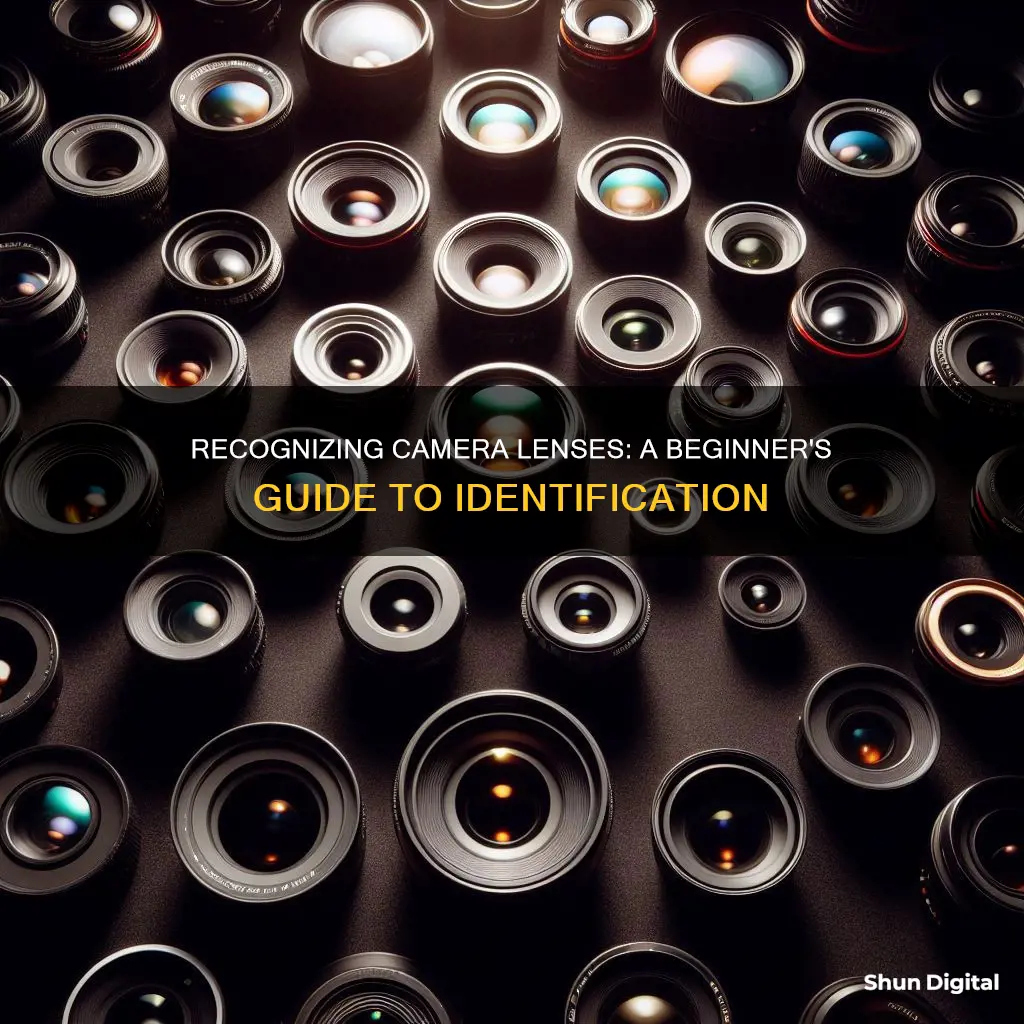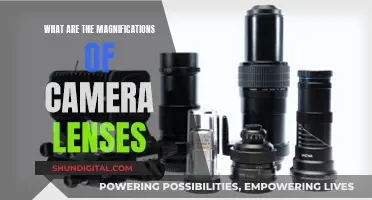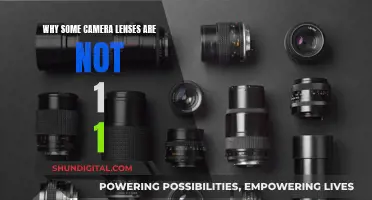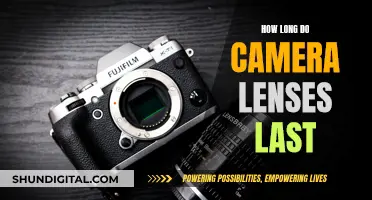
Camera lenses are essential to taking sharp, high-quality photos. When it comes to purchasing a lens, the number of options, specifications, acronyms, and features can be overwhelming. However, with a little knowledge, you can learn how to identify the key characteristics of a lens and choose the right one for your needs. In this guide, we will break down the features and terminology of camera lenses to help you make an informed decision. We will cover topics such as focal length, aperture, image stabilization, lens mounts, and more. By the end, you should be able to confidently identify different camera lenses and select the best one for your photography.
Camera Lens Characteristics
| Characteristics | Values |
|---|---|
| Focal length | Written in millimeters and found on nearly every camera lens |
| Aperture | Measured in "f-numbers" or "f-stops" |
| Diameter | Measured in millimeters and found on the front of the camera lens or engraved on the side |
| Focus | Automatic or manual |
| Image Stabilization | Optical Image Stabilization (OIS) or Vibration Reduction (VR) |
| Full-frame | Full-frame cameras use larger sensors, allowing for more light to enter the camera and higher-quality photos to be produced |
| Mount | The connection between the lens and camera body |
| Autofocus Motor Designation | USM (Canon), AF-S (Nikon), HSM (Sigma), LM (Fuji), and USD (Tamron) |
| Glass Element Descriptor | UD (Canon), ED (Nikon, Sony), EBC/Super EBC (Fuji), XR (Tamron), and ASP (Sigma) |

Aperture
The aperture not only controls the amount of light that enters the camera but also affects the depth of field in an image. A large aperture (e.g. f/1.4) will create a blurred background with a shallow focus effect, which is popular for portrait photography. Conversely, a small aperture (e.g. f/16) will result in a sharper image with a wider depth of field, which is ideal for landscape photography.
It's important to note that small f-numbers represent large apertures, and large f-numbers represent small apertures. For example, f/2.8 is a larger aperture than f/4. This is because aperture is a fraction, so f/16 is a much smaller aperture opening than f/2.8.
The maximum aperture of a lens is usually included in the name of the lens and is considered one of the most important specifications. A "fast" lens with a maximum aperture of f/1.4 or f/1.8 can pass through more light than a "slow" lens with a maximum aperture of f/4.0. This makes fast lenses ideal for low-light photography.
When choosing the right aperture, consider the depth of field and exposure you want for your image. For shallow depth of field and brighter exposure, use a large aperture like f/2.8. For wider depth of field and darker exposure, use a small aperture like f/8 or f/11.
Additionally, the aperture can affect the sharpness of an image. Very small apertures like f/22 can cause diffraction, resulting in a loss of sharpness. Most lenses tend to be sharpest around f/4, f/5.6, or f/8.
The Ultimate Guide to Cleaning Coated Camera Lenses
You may want to see also

Focal length
Lenses are typically categorised into prime and zoom types. Prime lenses have a fixed focal length, while zoom lenses have variable focal lengths. For example, a portrait lens may have a fixed focal length of 35mm, whereas a zoom lens might have a focal length range of 18-55mm. The focal length of a lens is usually indicated by the numbers immediately before the "mm" marking in the lens name.
When choosing a lens, it is important to consider the type of camera you have, as the sensor size will impact the apparent focal length. For instance, a lens that is considered wide-angle on a full-frame camera might be considered "normal view" on a crop sensor camera.
Cleaning Camera Lenses: Removing Dust and Maintaining Clarity
You may want to see also

Image stabilisation
Image stabilization is a feature found in both lenses and camera bodies that attempts to counteract vibrations and other tiny movements that could lead to a blurry photo. It allows photographers to capture sharp pictures at shutter speeds three, four, or five times slower than previously possible.
There are two types of image stabilization: lens-based and in-camera. Lens-based stabilization uses a floating lens element that is shifted in the opposite direction to any camera shake recorded by the camera. In-camera systems, on the other hand, physically shift the image sensor to compensate for these movements.
Lens-based stabilization tends to offer smoother performance when using longer focal length lenses. However, it is not available as an option for all lenses and adds to the cost. In-camera stabilization, on the other hand, works with any lens you can mount on the camera and is considerably more affordable. However, it is less effective when using longer focal length lenses.
Image stabilization is particularly useful when shooting in low-light conditions or with longer lenses. It prolongs the shutter speed possible for handheld photography by reducing the likelihood of blurring the image from shake. It also helps to stabilize the viewfinder, making it easier to correctly frame your shot, especially with longer telephoto lenses.
It's important to note that image stabilization only compensates for the normal, minute shaking of a lens due to handheld shooting. It does not prevent motion blur caused by the movement of the subject or extreme movements of the camera. Additionally, when using a tripod, it is generally recommended to turn off image stabilization to avoid creating a feedback loop that can introduce motion blur.
Motorized Telescoping Lenses: Are They Reliable Camera Companions?
You may want to see also

Lens mount
The lens mount is the connection between the lens and the camera body. Lenses from one camera body maker will not fit directly onto the body of another camera body maker, although there may be an adapter available. Some camera and lens manufacturers are incredibly consistent with their mounts. For example, Canon EF lenses will mount onto any Canon camera since they transitioned to autofocus. Other manufacturers will have multiple mounts for different camera body lines, such as Sony's A and E mount cameras.
A lens mount is an opening of a specific size on an interchangeable lens camera that allows for attaching lenses designed for that mount. In the early days of photography, lenses were only mechanically attached to cameras without any communication between the two. However, with the advent of automatic metering and autofocus systems, it became necessary to create electronic contacts on both cameras and lenses to enable communication between the two. As a result, a lens mount became more than just a physical hole, but rather an interface between the lens and the camera.
Today, practically every lens mount for photography is a bayonet mount, where three to four tabs are used to lock a lens tightly in place. With a bayonet mount, one aligns a marked section of a lens (typically a coloured dot) with the marked section on a camera body, then after coupling the two, twists the lens either clockwise or counter-clockwise (depending on the brand/mount) until it locks into place. The locking mechanism is mechanical, with a spring-loaded pin locking the lens in place in its proper position, requiring the pin to be retracted when a lens needs to be detached (usually done via a button next to the camera mount).
The size of the mount is an important factor in a camera system. Generally, a larger mount size allows for larger lenses that can provide more light to the sensor. Hence, faster lenses can be designed. At the same time, mount diameter is not the only variable that impacts lens design – flange distance is also key. A shorter flange distance allows lenses to be placed closer to the sensor, which in turn allows lens manufacturers to start building simpler, smaller, lighter, and less expensive short-focus lenses.
Due to the proprietary nature of all camera mounts, each one of them can differ in mounting direction, mount size, flange distance, the number of electronic contacts, and even the placement of the electronic contacts.
Cleaning Paint Off Your Swann Camera Lenses: A Quick Guide
You may want to see also

Lens size and weight
The size and weight of a lens are important factors to consider when purchasing a new lens. While it is usually not a big deal, there are a few things that the diameter of your lens will affect, including the size and price of filters and whether you can use a filter at all.
Determining Lens Diameter
The diameter of your lens is different from the focal length and aperture. It is the physical measurement of the diameter of the front-most part of the lens and is often marked on the lens using the symbol "ø" followed by a number (e.g., ø52 for 52mm). Common DSLR lens diameters include sizes like 43mm, 49mm, 52mm, 58mm, 62mm, 68mm, 72mm, and 77mm.
If the diameter is not marked on the lens, you can measure it with a ruler or tape by measuring the widest part of the lens. However, there is an easier way to determine the diameter: by reading the numbers that are on 90% of all lenses, around the inner glass/threads. This number next to the symbol is your lens/thread diameter.
Lens Size and Focal Length
It is important to note that the size of a lens is related to its focal length. Longer focal lengths result in larger lenses, while shorter focal lengths lead to smaller lenses. This is because longer focal lengths, such as telephoto lenses, require more glass elements to achieve the desired magnification and image quality. Conversely, wide-angle lenses, which have shorter focal lengths, can be more compact.
Lens Weight
When buying a lens, it is essential to consider its weight. A heavier lens can be more cumbersome to carry around and may require a sturdier tripod or support system to avoid camera shake. Additionally, a heavier lens can impact the overall weight of your camera setup, affecting your shooting style and portability.
Lens Size and Image Quality
While image quality is influenced by various factors, lens size can play a role. Lenses with extreme specifications, such as superzooms or extremely wide apertures, may have compromises in image quality, size, weight, or price. However, modern lenses are sharper than ever, and the limit of sharpness in your photos is likely to be your technique rather than your lens.
Specialty Lenses
Specialty lenses, such as macro, fisheye, and tilt-shift lenses, have unique characteristics and applications that can enhance your photography. Macro lenses allow you to capture intricate details of small subjects, fisheye lenses offer an extreme wide-angle perspective and distinctive visual effects, and tilt-shift lenses provide control over the plane of focus and perspective in your images.
Lens Size and Camera Compatibility
When considering lens size, it is crucial to ensure compatibility with your camera model. Different camera brands have their own lens mounts, and adapting lens sizes from one brand to another may require the use of lens adapters. Additionally, different camera models have varying sensor sizes, which can affect the image quality and field of view when using certain lenses.
In conclusion, lens size and weight are important factors to consider when choosing a lens. They can impact filter selection, image quality, portability, and compatibility with your camera system. By taking these factors into account, you can make an informed decision and choose a lens that suits your specific photography needs and style.
Cleaning Camera Gear: Rubberized Coating Care
You may want to see also
Frequently asked questions
The focal length, maximum aperture, and image stabilisation are critical characteristics of a lens. The focal length is indicated by the numbers before the "mm" marking, with prime lenses having a single focal length and zoom lenses listing a range. The maximum aperture is the number after the "f/" marking, which may be a single or multiple numbers depending on the lens type. Image stabilisation is a mechanism that compensates for handshake when hand-holding the camera.
Nikon's lens mount has remained the same since the introduction of their first SLR, the F. However, older "non-ai" lenses won't fit modern DSLR cameras. Look for "rabbit ears" at the top of the lens to identify an AI mount. AF-D lenses will fit any camera but won't autofocus unless the camera has a built-in motor.
Canon changed its lens mount when introducing autofocus lenses. FD lenses are not compatible with newer cameras, and vice versa. FD lenses have a "female" bayonet, while EF lenses have contacts that remain visually identical. EF lenses also lack physical controls for the aperture.







